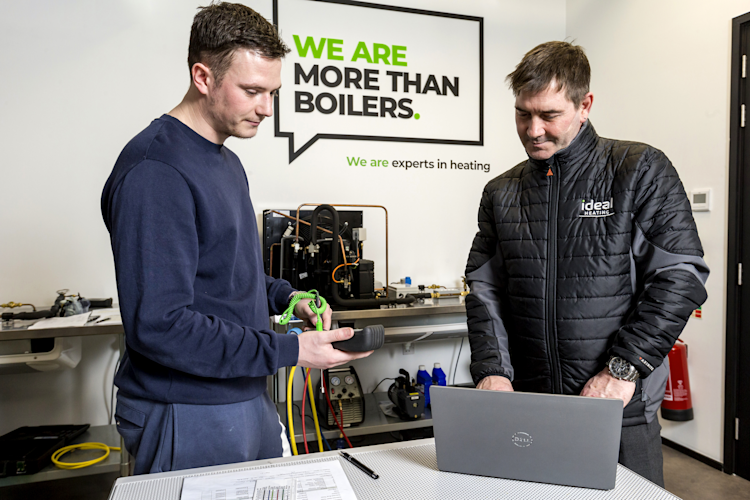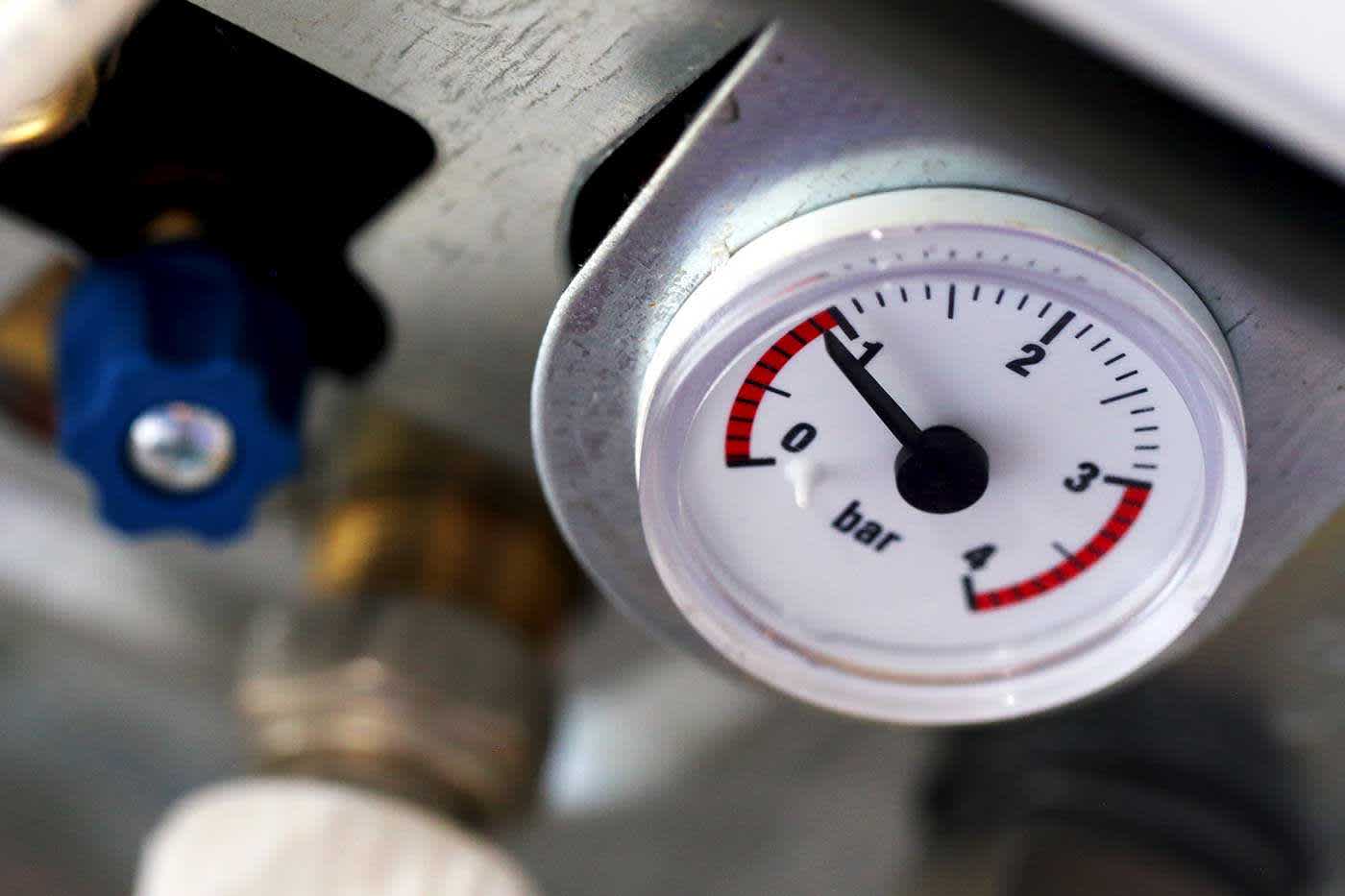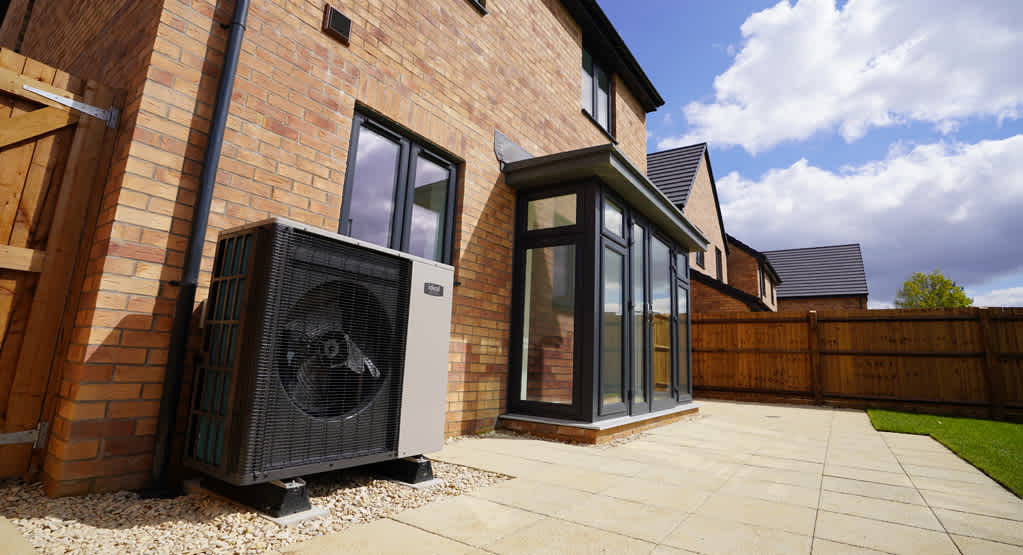
Radiator cold at the bottom? Possible causes & solutions
Is your radiator cold to the touch at the bottom and you’re not sure how to fix it? With Ideal Heating’s top tips, you’ll be able to identify possible causes and find out what you can do to fix the problem.
We all know that heat rises, so having a radiator that’s cooler at the bottom than the top might not seem like cause for alarm. However, radiators are designed to emit heat evenly once your central heating has kicked in - they should never be colder at the top or cold at the bottom once the system is up to temperature. If your radiator usually gets hot, but now appears to be only hot at the top but not at the bottom, it may require further investigation.
How do radiators work?

First thing’s first: to understand why your radiator might be cold at the bottom, you’ll need to have a basic understanding of how your radiators work.
Water heated by your boiler enters a double loop of pipework that ultimately returns to the boiler so that it can be reheated after it has cooled. Radiators around your property branch off this loop; each one takes hot water from the flow loop, circulates it around the radiators, then passes it to the return loop to let it leave on the other side. Most common central heating systems work like this, however more recent systems have a manifold arrangement, where flow and return connections are provided independently to each radiator.
Inside the radiator, hot water is directed through channels that keep it flowing first sideways and upwards, then downwards to the exit piping. That means the whole surface is covered with constantly moving hot water while your central heating is active.
If the boiler is switched off or the thermostat temperature is reached, the flow will cease and the radiators will begin to cool down. As soon as the boiler fires up again, your radiators will start to warm up again.
Looking for a new boiler to power your radiator?
Choose from Ideal Heating’s range of Combi, System and Heat only boilers.
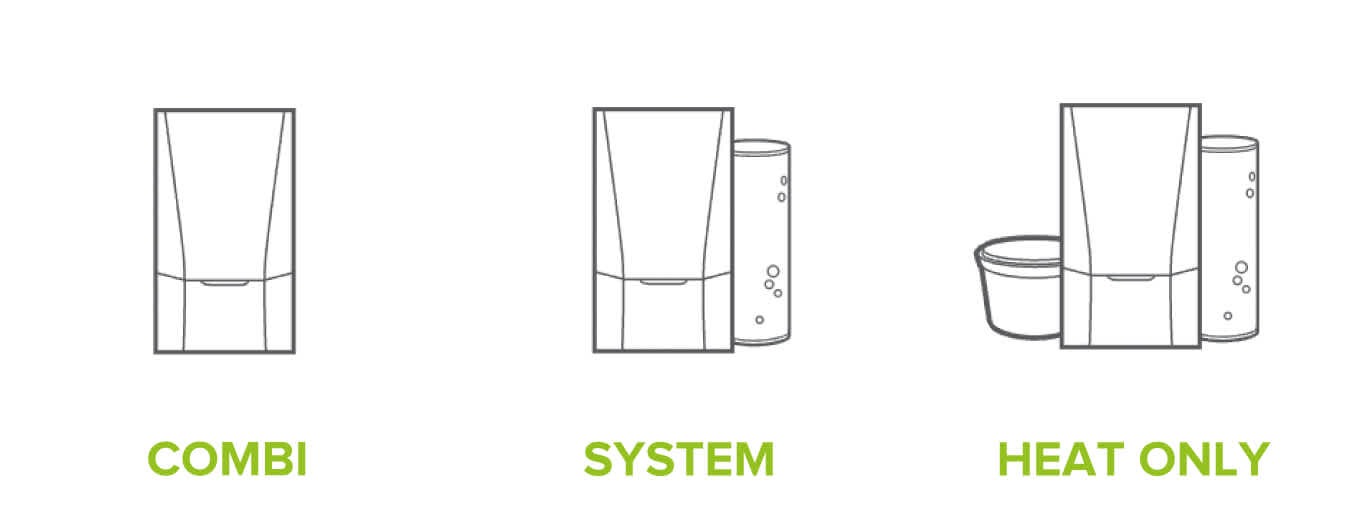
Why is my radiator cold at the bottom?
If your radiators are cold at the bottom but hot at the top, this means the flow of hot water is being restricted or redirected; this is usually caused by a build-up of sludge.
This means the hot water is not reaching the whole of the radiator while the central heating is on, leaving it cold at the bottom.
This will leave your radiator hot around the water entry and exit points at the bottom - the sludge is usually found in the middle and at the bottom of the appliance.
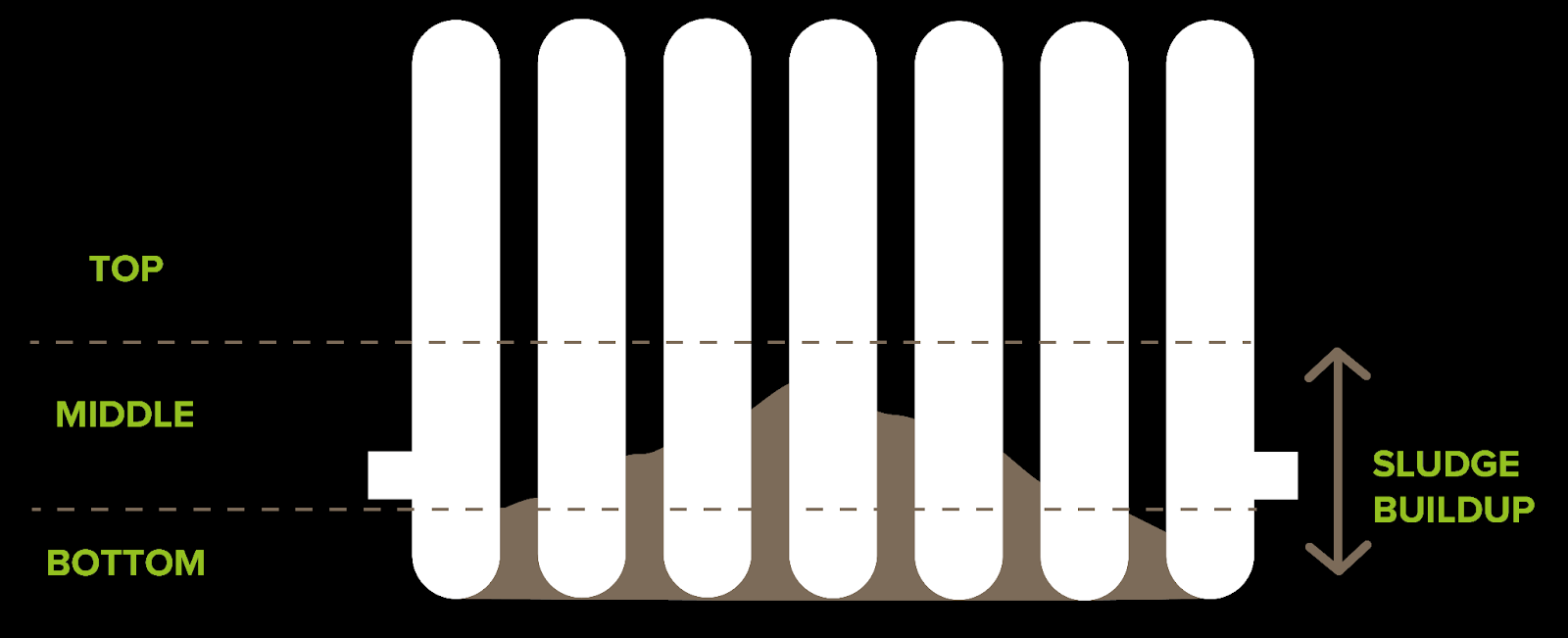
The culprit in 99% of these cases is a build-up of sludge and grime. Radiators are often made of steel or iron, so iron compounds will gradually be created as the water passes over it. Magnetite and haematite (two forms of iron oxide) are the biggest problems, but there can also be other impurities in the water like limescale that can cause grime to accumulate. Once a small accumulation has started, it’s easy for more material to add to it and it quickly multiplies.
As soon as the sludge has grown enough to block off one of the flow channels inside the radiator, that channel will no longer let hot water through it, and that accounts for the coolness in concentrated areas. If several channels are blocked, the whole of the bottom part of the radiator will not be getting any hot water. Any residual warmness in these parts of the radiator is coming from the radiator’s metal being warmed, and perhaps a small amount of warming from the sludge.
Iron compounds won’t form in your steel or iron radiator if a corrosion inhibitor has been added, which is highly recommended.
It’s also worth noting that aluminium radiators - the most common type in some European countries and gaining popularity in the UK - don’t suffer from iron oxide sludge build-up if there is no steel in the system.
Why is the radiator hot at the top, but cold at the bottom?
If your radiator is cold at the bottom, it’s likely to be caused by a build-up of sludge, as we mentioned earlier. It’s not likely to be caused by trapped air and thus bleeding your radiator won’t fix the problem. Typically, the most common symptom of trapped air in your radiator is coldness at the top.
Just one radiator is cold - How do I fix it?
If just one radiator is warm at the top and cold at the bottom, it’s likely to be an issue with that individual radiator rather than a problem with your overall heating system.
In the majority of cases, the single radiator causing the issue may just need a good clean! Cleaning a radiator thoroughly can be a tricky job so you may want to contact an engineer for assistance. If you’re confident enough to clean the radiator yourself, scroll down for further instruction.
How to fix radiators that are cool at the bottom
There are three ways of solving this problem: chemical, physical cleaning and a power flush.
Add cleaner to your radiator system
A chemical can be added to the radiator system that will clean up the sludge, just like you’d pour drain cleaner down the plug hole. It’s a one-off job – you add the cleaner to the system, let it warm up and run for an hour or so, then flush it out and replace the water.
In particularly severe cases, the cleaner can be left in for up to a week, but once it’s done its work, it needs to be removed and replaced with fresh water. Cleaning your radiator this way is probably best left to a professional central heating engineer, so we won’t go into detail on how it�’s done.
Clean your radiator
If you don’t want to use a chemical cleaner or involve an engineer, you could choose to remove and clean a radiator yourself. This process isn’t too hard if you’re a relatively accomplished DIYer and, if only one radiator is affected, this could be all you need to do.
How can I clean my radiator?
Step one: Isolate your radiator
Do you have a thermostatic radiator valve (TRV)? Great - turn this down to zero. At the other end there will be another valve called a lockshield valve, which is probably covered with a plastic cap. Close the valve with a spanner, but note the angle that you have to turn it – it’s probably somewhere between a quarter and half a turn. That’s how much you’ll want to open it later. If you don’t have a TRV, you’ll need to turn off both valves with a spanner.
Wait for at least half an hour to ensure the water in your radiator is cold - the last thing you want is boiling hot water pouring across the room.
Step two: Prepare for leaking water
You’re going to be emptying your whole radiator - so expect a lot of water! Have a couple of containers to hand to make sure you can capture all of it with no spillage or overflow.
It’s also sensible to put an old towel or rags down underneath the connector nuts, with your container placed on top to make sure that any leaks can be easily cleaned away.
Next, with a spanner, turn the radiator nuts slightly. A small amount of water might drip out, but don’t expect water to start pouring out just yet.
Step three: Open the bleed valve
Using a bleed key, open up the bleed valve at the top of the radiator. Air will now be let into the radiator, and water will start pouring out near the loosened nuts.
Step four: Remove and clean your radiator
Once the water has stopped flowing, disconnect the valves and lift the radiator off its brackets. Make sure not to fully undo the valves, as this can empty the content of your heating system. Take the radiator outside, attach a water hose to one end and blast water through it for a few minutes until it flows clean. You can try the hose in different openings to make sure.
Step five: Replace your radiator
Re-hang the radiator on the brackets, re-attach the pipes at the nuts and turn both valves back to their original positions. Water will start refilling the radiator, so get ready with your bleed key and close the bleed valve as soon as water begins to escape from it.
Step six: Test your system
You should now test your radiator by turning your heating back on. Wait for around twenty minutes for the water to heat up, and test it by placing your hand on the bottom of the radiator and swiping up - your radiator should be emitting heat evenly now.
Once you take a radiator off a sealed system, the system will nearly always need repressurising.
If you have a pressurised system, more water will need to be added to the loop to bring it back to pressure.
How to power flush to clean your radiator out
A power flush is basically the same as the operation above, except you don’t remove the radiator – a professional will need to force high-pressure water through the system and use specialist chemicals to clean it out. This cleans all the radiators, not just one, so if you are noticing more than one radiator is cold at the bottom then this may be the best solution for you. A power flush is a tricky job that needs specialist equipment and knowledge, so leave it to the professionals.
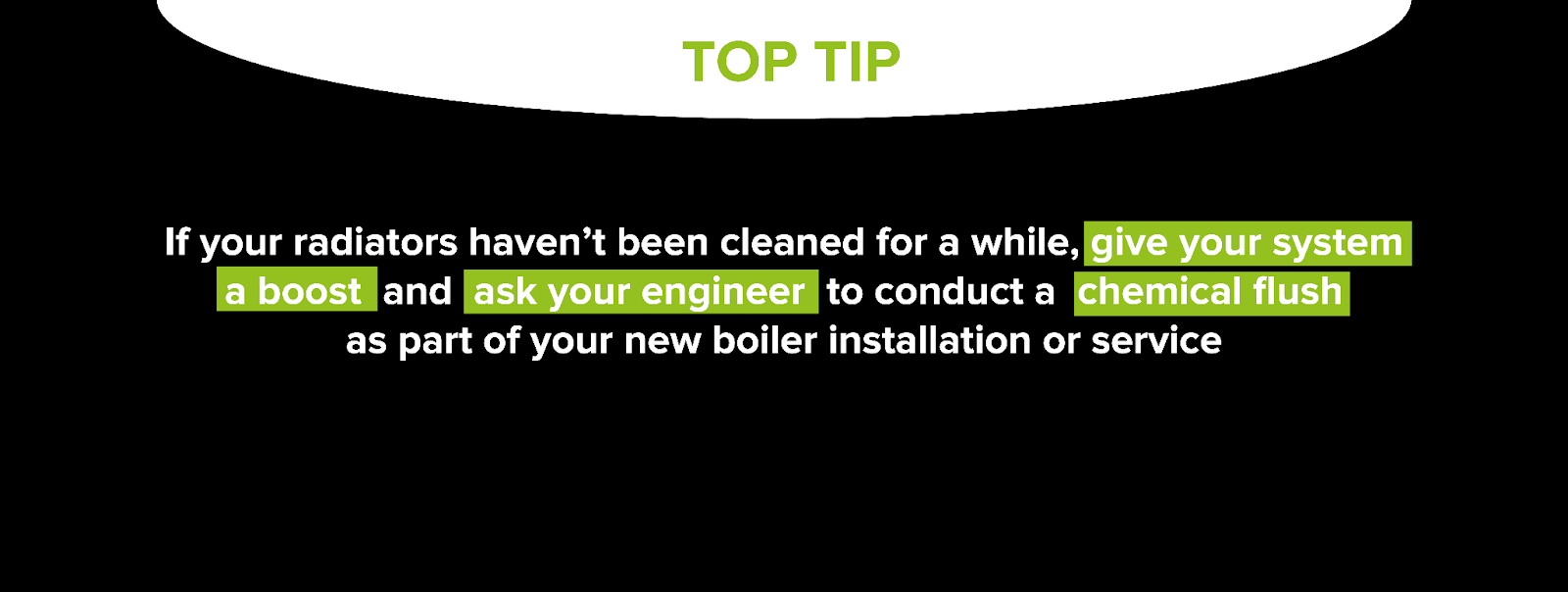
How to prevent your radiator getting cold at the bottom
Radiators being colder at the bottom than the top is often caused by sludge build-up. As with most things, it’s much better to prevent the problem rather than trying to solve it retrospectively.
We strongly recommend looking after your radiators by trying to prevent sludge from building up in the first place. The easiest way to do this is to put an inhibitor into the system. It slows down the chemical reactions that cause the iron oxides to form, so you’ll get much more life out of the system. Using a chemical inhibitor is required to comply with the industry benchmark best practice scheme, so it’s more important than even to look after your radiators and use an inhibitor.
The importance of fitting a system filter
You should also consider installing a magnetic boiler filter in the loop, which takes out grime before it gets a chance to settle and accumulate. A system filter will collect any debris in the system, allowing easy removal without having to resort to the complexity of cleaning, removing or power flushing your radiators.
Remember - if you look after your heating system and prevent problems from arising in the first place, you’re less likely to endure the stress of having a cold or faulty radiator.
Other common radiator problems
As well as being cold to the touch at the bottom, it’s common for radiators to also be cold at the top. It’s also fairly easy to solve this problem; simply bleeding your radiator should sort the problem in no time.
For more tips and advice, bookmark Ideal Heating’s blog.














